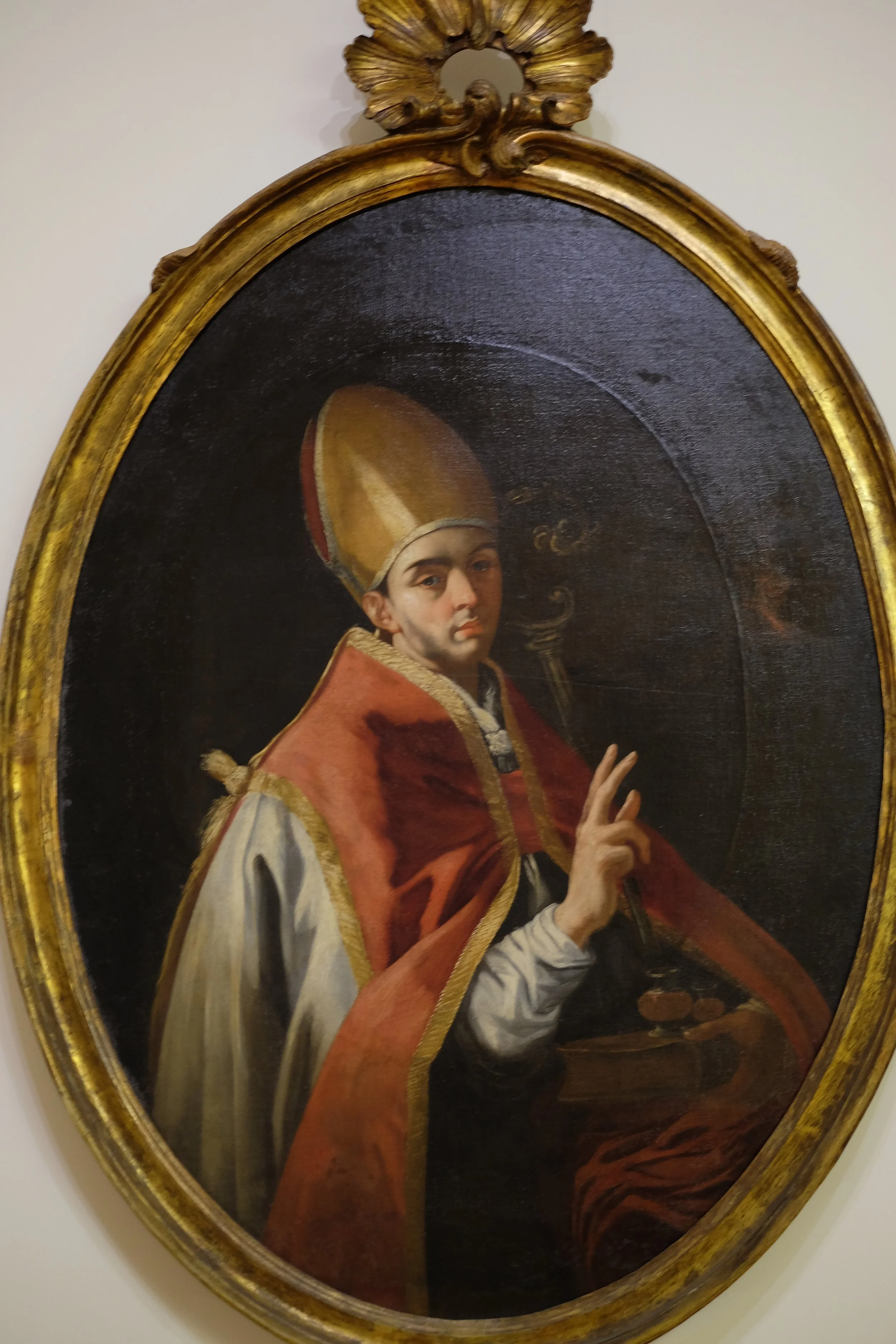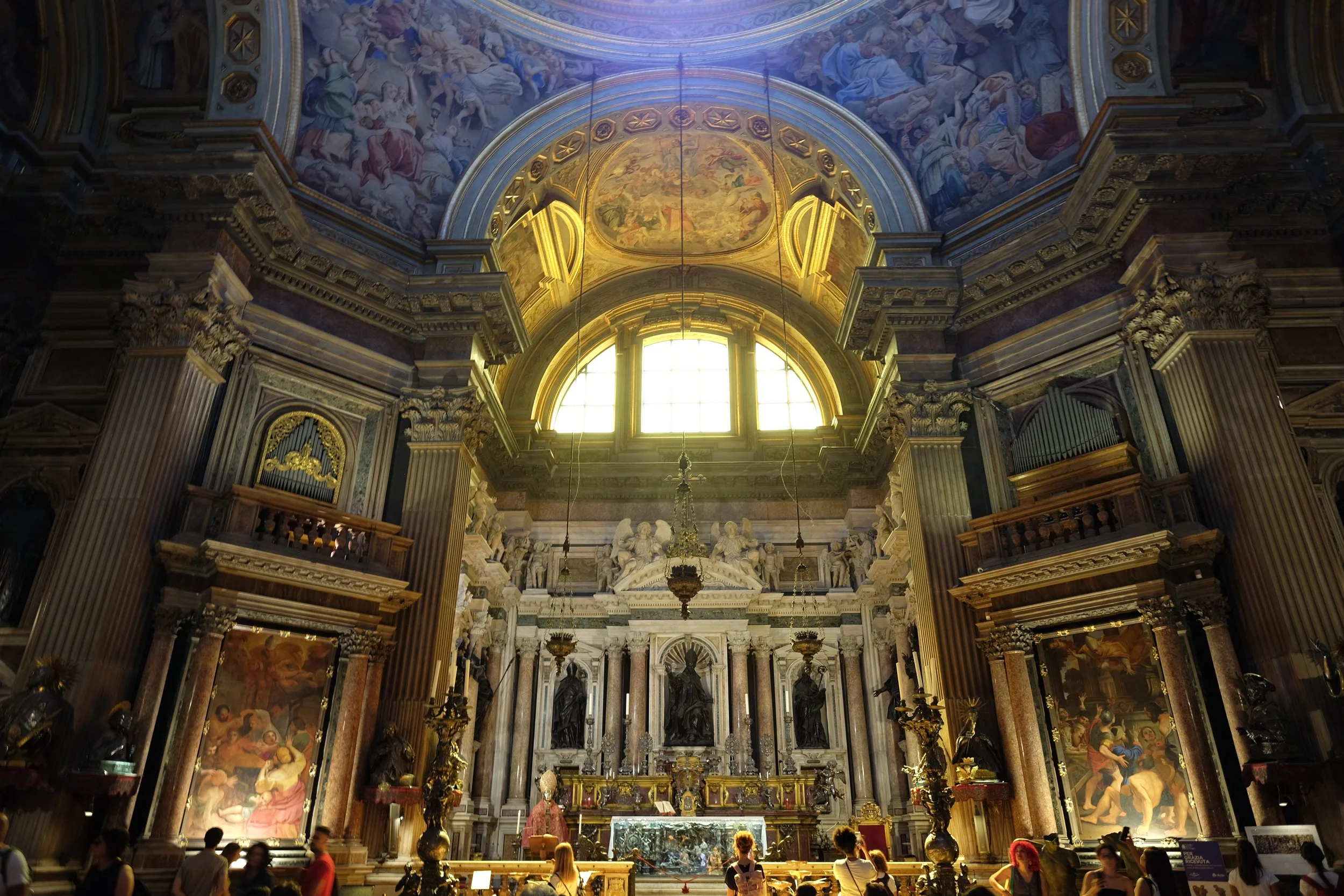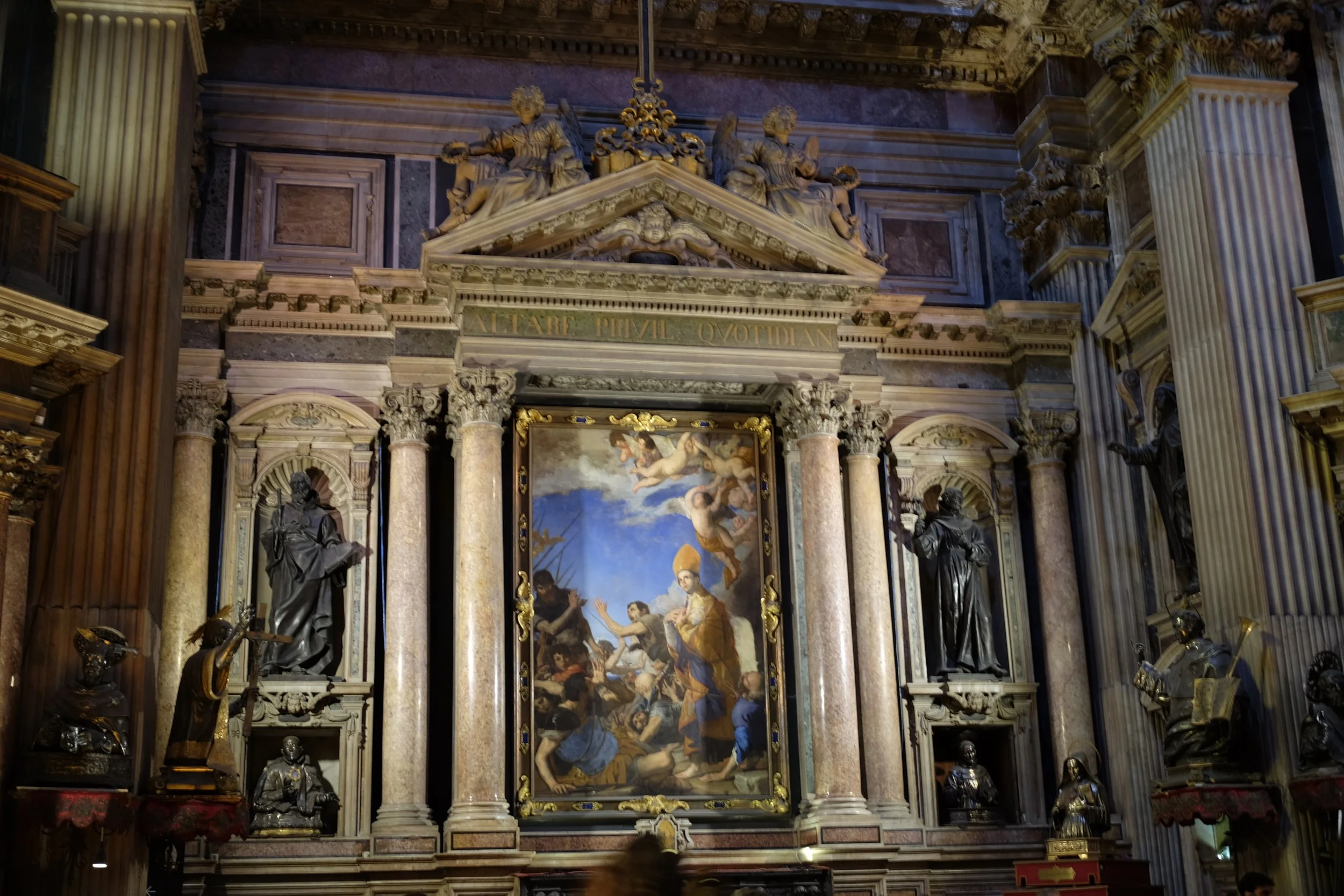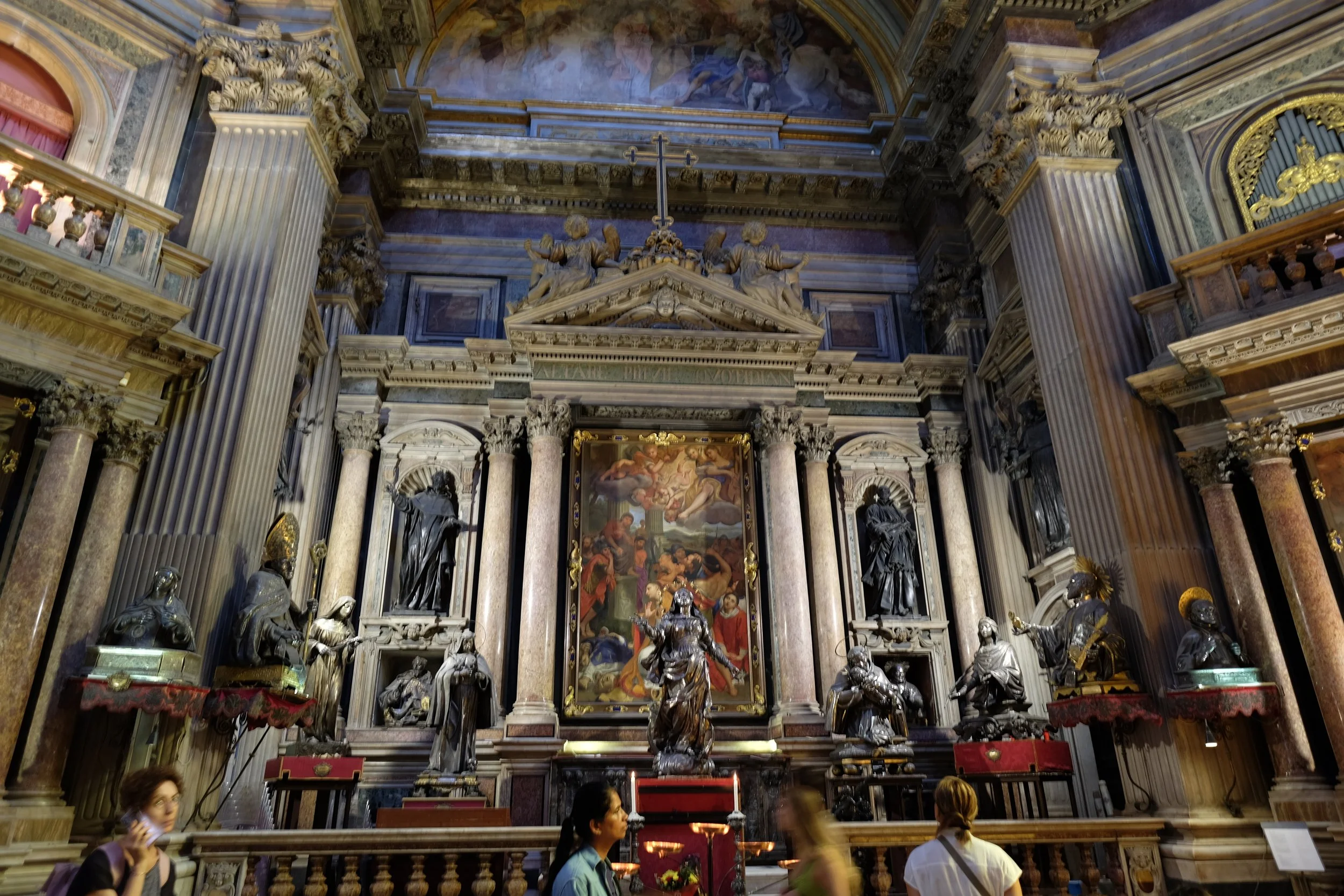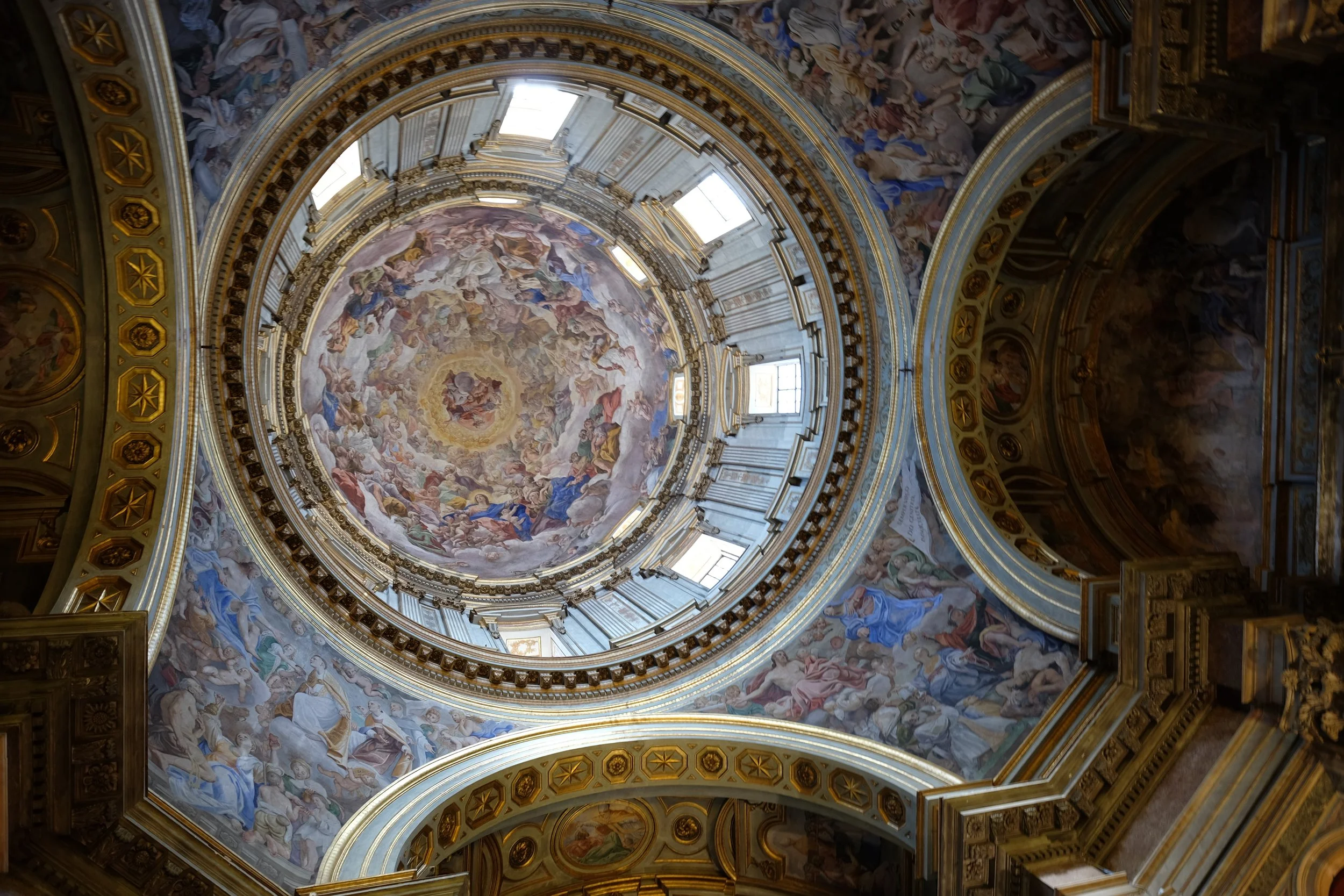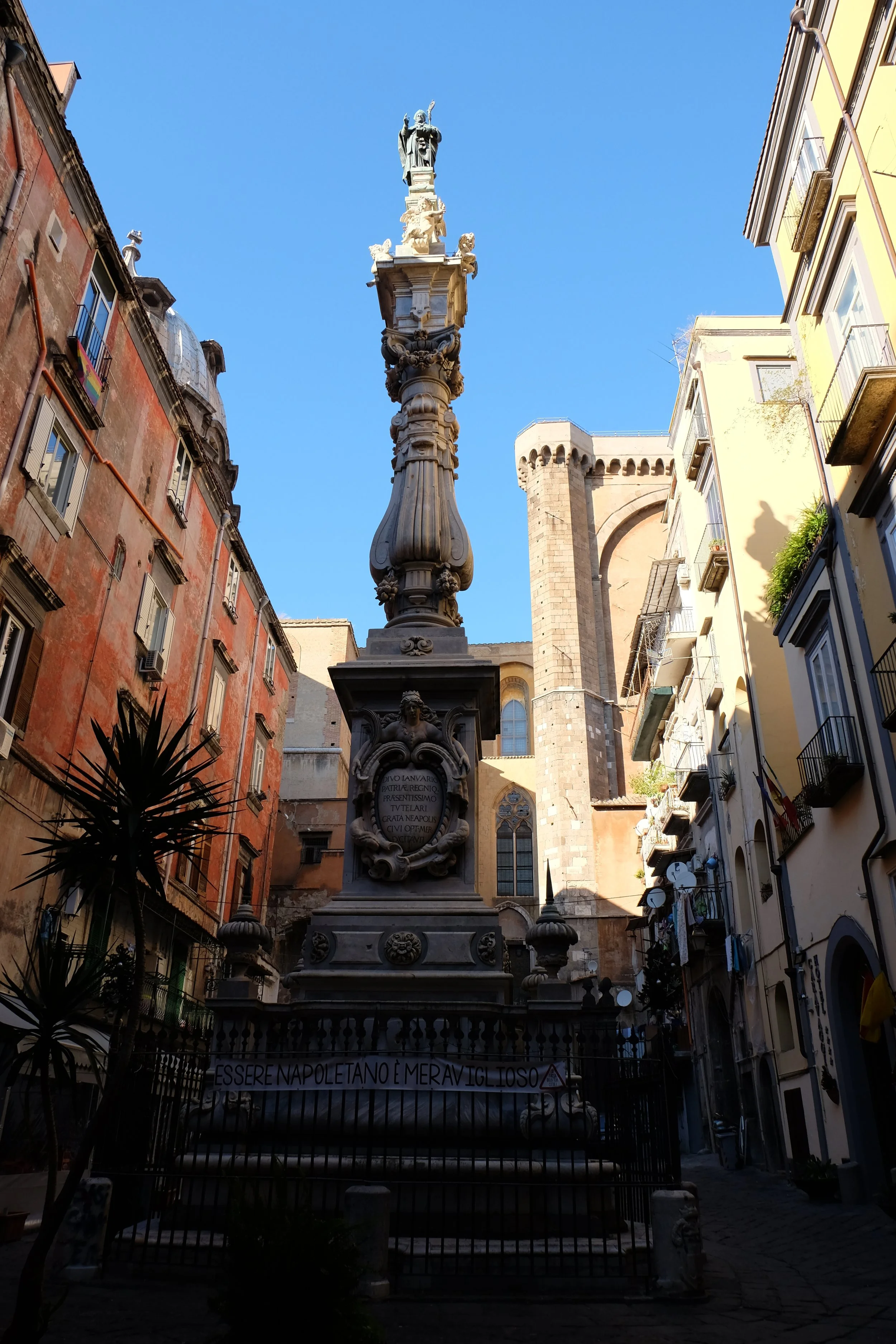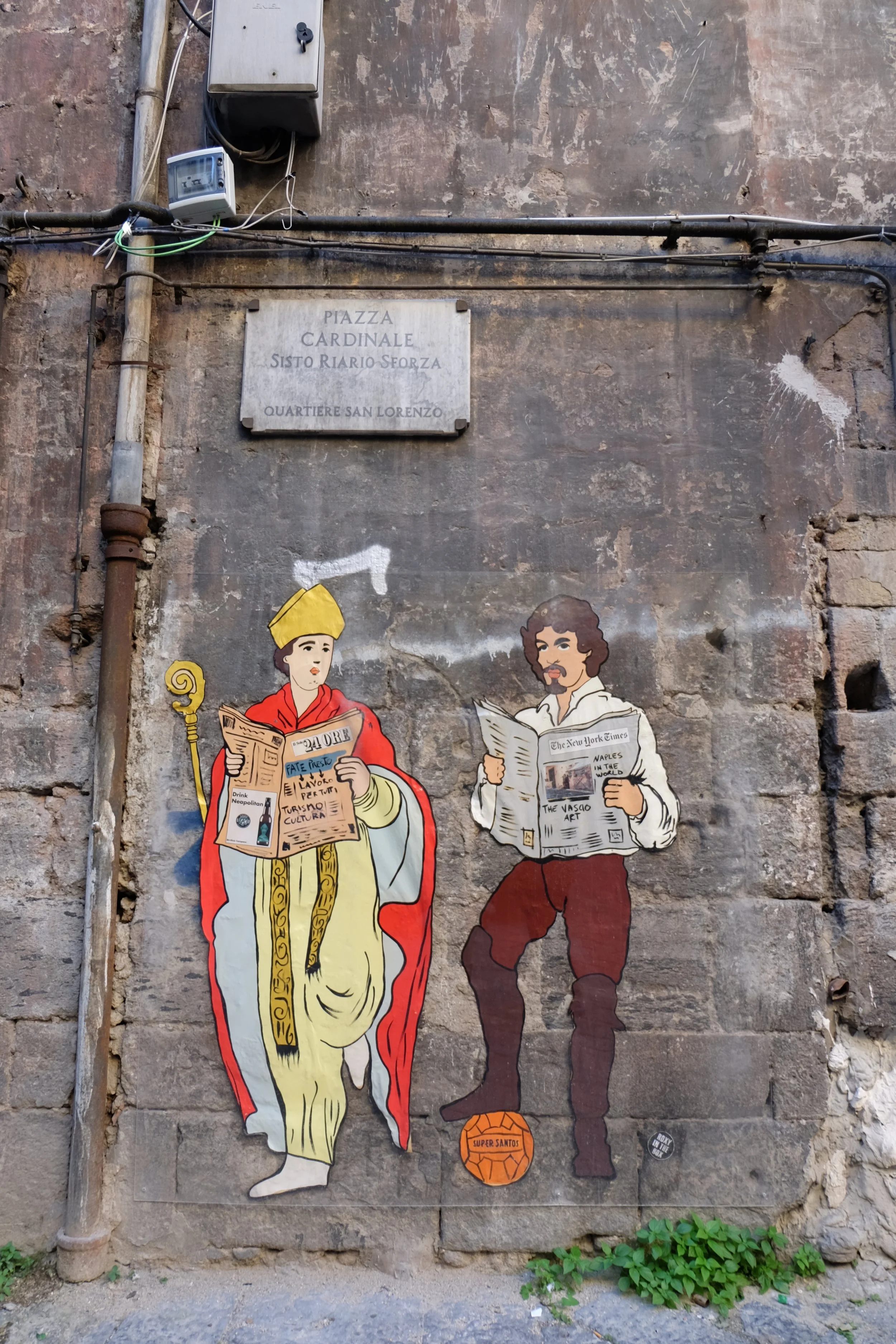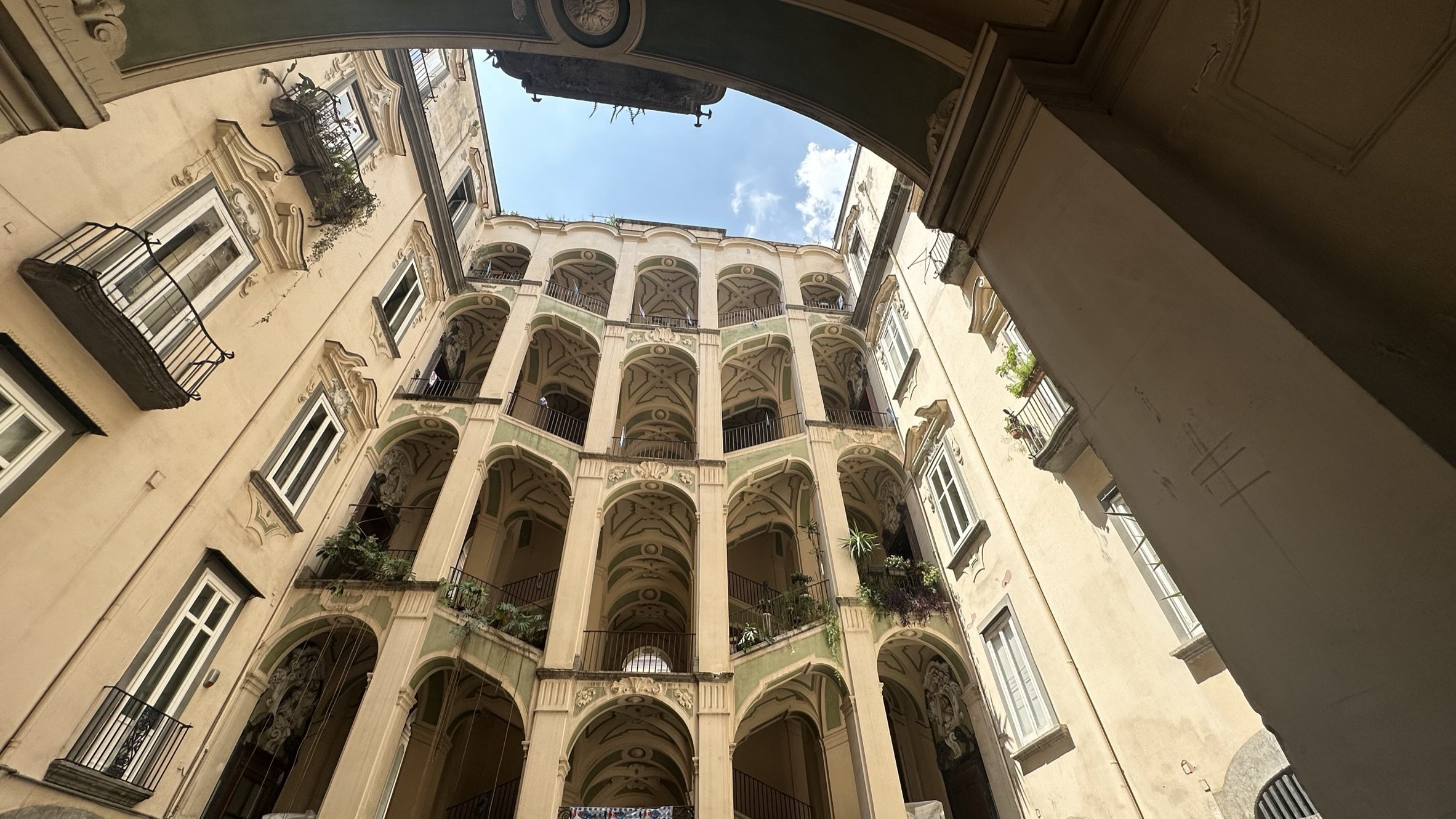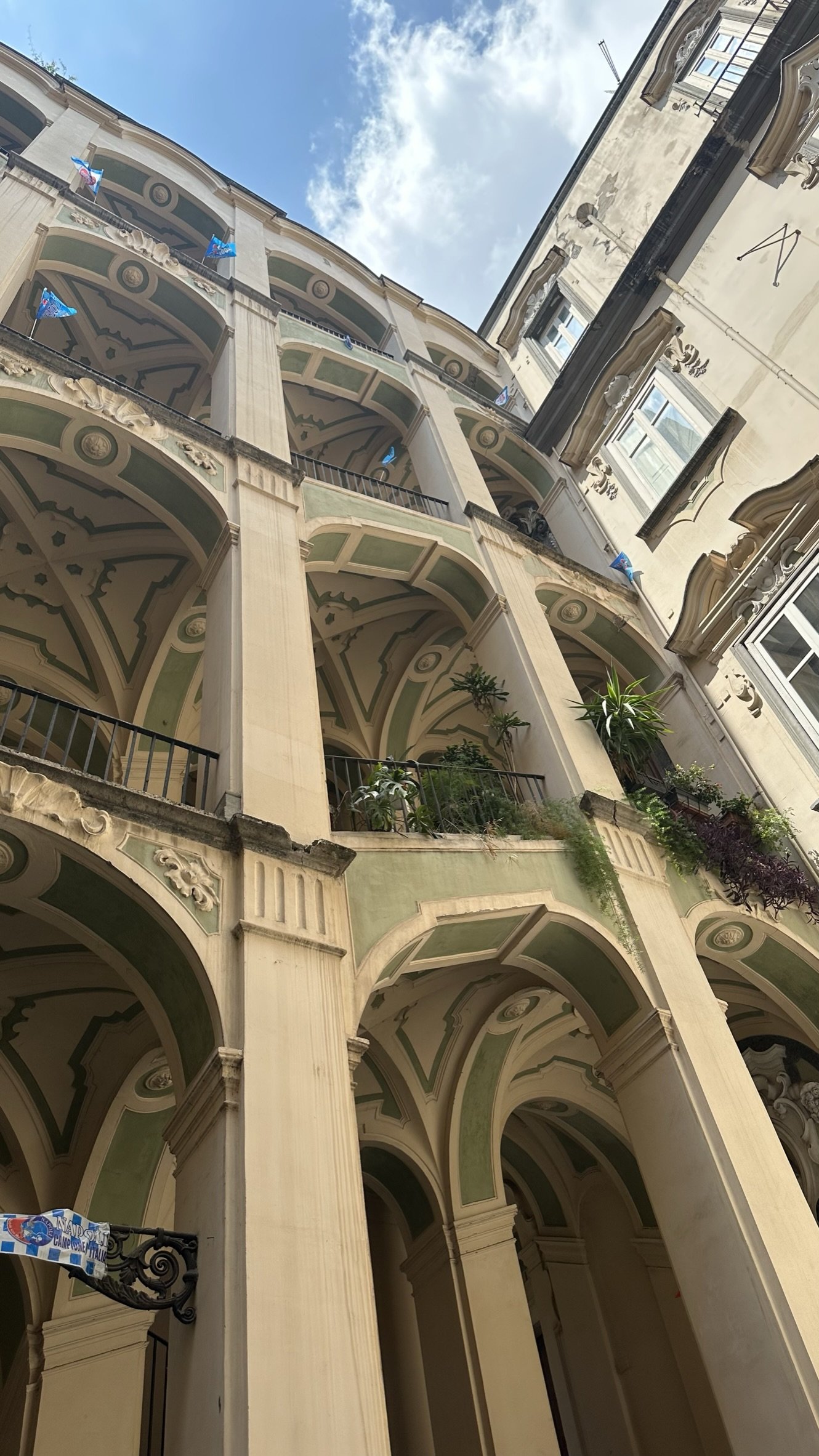When you come to Napoli, the face of San Gennaro (after Maradona) is everywhere, in graffiti, statues, posters and banners.
Saint Gennaro (Saint January) is the patron saint and protector of Napoli and Neapolitans have a very deep love and affection for him.
We celebrate the feast day of Saint Gennaro every year on September 19th.
The origin of the name Gennaro, which is very popular in Napoli, comes from the latin Ianuarius, which means “consecrated to the god Janus” and often referred to children born in the month of January.
Street art inspired by San Gennaro. This graffiti by the street artist Jorit is in the Forcella area, not far from the Cathedral.
Portrait of San Gennaro in San Lorenzo church.
The history of the devotion towards this Saint is shrouded in mystery. We don’t know much about him, but what we do know is that he was a bishop and a martyr, possibly born in Napoli or Benevento around 272 and died in Pozzuoli in 305.
According to the legend San Gennaro was bishop of Napoli and was arrested in Pozzuoli during the last persecution of Christians by the Roman Empire, where he was protecting his fellow christians.
There are differing stories of his death. One version was that he was captured and torn to pieces by lions. Another was that he was tortured but it had no effect, so he was thrown into a furnace from which he came out unharmed. Another version says that he was decapitated at the Solfatare crater. Some of his remains were stored, and his blood kept in two ampules, which are now kept in the Duomo (Cathedral) of Napoli.
The cult of San Gennaro is a mixture of religion, tradition, faith and folklore.
In 431, King Charles II Angiou of Naples ordered a very precious relic bust to be made by the finest french goldsmiths, in order to keep the skull and the two ampules of blood of the saint inside.
In 1305, San Gennaro’s bust was put on public display, to be venerated by the Neapolitans. King Charles’ son Robert, further ordered another handheld case to be made, just to keep the two ampules of blood inside. It had a glass window at the centre so you can see the ampules of blood and that is how we see it today.
The fame of Saint Gennaro is related to the miracles made by the liquefaction of his blood. According to old documents, during the famine of 1389, there was the very first miracle of the liquefaction of his blood, which coincided with the ending of the famine.
Between 1526 and 1529 there was a terrible plague in the city so the Neapolitans made a vow to build a Chapel in his honour so that he might protect them.
One of his most famous miracles performed was that during a procession with his statue Vesuvius erupted but the lava miraculously didn’t touch the city.
Neapolitans then built the San Gennaro chapel in the Duomo of Napoli, which was consecrated in 1646. It is richly decorated with marble, gold and silver, as well as with busts and paintings illustrating the life and legends of the saint, created by many artists of the Neapolitan Renaissance and Baroque with sculptures by Cosimo Fanzgo, frescoes by Domenichino and paintings by Jusepe de Ribera. Around the Chapel there are almost 50 sculptures and statues of San Gennaro and other co-patron saints made by many prestigious European goldsmiths.
At the top of the entrance there is a sign in latin, which reads ”To san Gennaro, citizen and protector from wars, plague, hunger, and the fire of the Vesuvius, in virtue of your miraculous blood”.
The altar of the San Gennaro Chapel in the Cathedral of Napoli.
On the central altar, the handheld case where the two ampules with San Gennaro’s blood are kept.
On the right altar, the Spanish painter Jusepe de Ribera with the story of Saint Januarius Emerges Unscathed from the Furnace, 1646.
On the opposite altar, painting by Domenichino, 1641.
The frescoes of the dome are painted by Domenichino in 1641. and then completed it by Giovanni Lanfranco in the Paradise scene at the centre in 1643.
The miracle of the liquefaction of his blood happens three times a year: on the first Saturday of May, September 19th and December 16th.
The ceremony of the miracle is held in the Duomo (Cathedral) by the Bishop of Napoli and it is a very important event for the Neapolitans in a spiritual and a social way. The relics and the container with the blood are stored in the Chapel of the Treasure of San Gennaro. The bishop takes the container and a crowd gathers around to see if the dried blood contained inside liquifies. It doesn’t always happen but if it does, it’s a good sign for the city, especially it means the Napoli football team might win the league or the champions league!
If you want to attend the spectacle just make sure to get there very early in the morning as it gets very crowded very quickly.
San Gennaro obelisk (guglia) in Piazza Riario Sforza.
Small shrine to Saint Gennaro.
Two characters in the Neapolitan culture: San Gennaro and Caravaggio. The graffiti is by Roxy in The Box in piazza Riario Sforza.
The old gate of the city dedicated to San Gennaro in via Foria, on the border of the old town.
Many scientists have tried to study the miracle, analysing the dried blood to see if it loses viscosity by movement, shock or vibrations, like for instance the way tomato ketchup, which when poured starts off as solid and then becomes liquid.
Of course, it’s all about your personal beliefs. For those who believe it is very profound and moving event. For others it’s just a tourist attraction.
Near the Duomo (Cathedral), it is also possible to access the Museum of the Treasure of San Gennaro. Here you can find the astonishing treasure collection of Saint Gennaro which includes hats and necklaces decorated in gold and precious stones, donated over the centuries by Kings, Popes, Emperors, famous noblemen and normal people. The collection is believed to be more valuable than the British Royal family’s collection.
You can also visit San Gennaro’s catacombs, the underground necropolis under the Incoronata church in Capodimonte. This is believed to be the place where the Saint was buried and it has become a place of pilgrimage over the centuries.
To know more about the catacombs and to book your visit click here on the San Gennaro Catacombs official website.
Art crafts inspired by the imagine of San Gennaro very popular in the Neapolitan shops.
You can see how much Neapolitans are devoted to San Gennaro, he is everywhere. He is one of the most recognisable icons of Napoli, along with Vesuvius, Maradona and Pulcinella.
“San Gennaro pensaci tu” (lit. “San Gennaro, take care of it”) whenever you have a problem, a pain, even if you want the winning numbers for the lotto, San Gennaro can help you. It doesn’t matter if you believe it or not, Saint Gennaro will always be there to be a comfort, and a hope for those who ask for help.
The cult of San Gennaro’s is also celebrated worldwide among the Neapolitan diaspora. In fact one of the most important is in New York.
Despite wars, earthquakes, volcanic eruptions and pandemics Neapolitans always feel protected by San Gennaro. Always and for ever.
And who knows maybe he ’s got something to do with the Napoli football team winning their 4th scudetto in 2025!
You can visit my page to know more about the history of the Duomo Cathedral of Napoli.
Official website: Cappella di San Gennaro.
To book your tickets for the Museum of the Treasure of San Gennaro
Via Duomo 147 - 80138 Napoli
Tel.: +39 081 449 097 / Museum: +39 081 294 980 info: info@tesorosangennaro.it
Email: booking@cappellasangennaro.it
Cathedral - Free entry. You need tickets for the San Gennaro Chapel and the Museum of the Treasure of San Gennaro.
The San Gennaro Chapel is free every first Sunday of the Month.
Opening hours:
Cathedral: Mon - Sat 08.30 - 13.30 / 14.30 - 19.30 / Sun 08.00 - 13.00 / 16.30 - 19.30
San Gennaro Chapel: Mon. & Sat. 09.30 –13.00 (last admission 12.30) / 15.00–18.00 (last admission 17.30)
Tues. - Fri.: 09.30–13.00 / 14.30–18.00 (last admission 17.30)
Sunday: 09.00–13.00 (last admission 12.30) / 16.30–18.00 (last admission 17.30)
Museum: Every day 9.30 - 18.00 (last admission 17.00).
Nearest metro station: Linea 1 - DUOMO or MUSEO.

